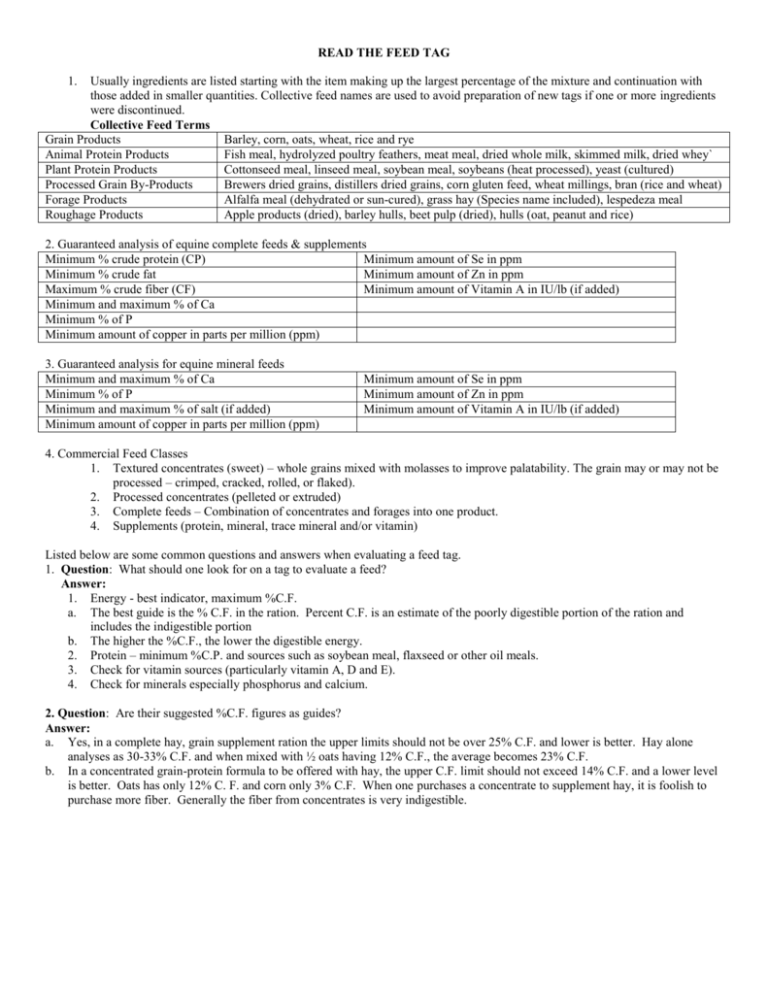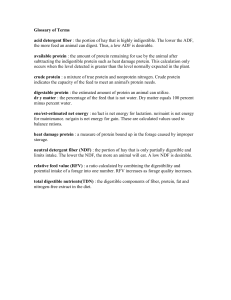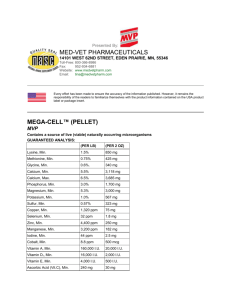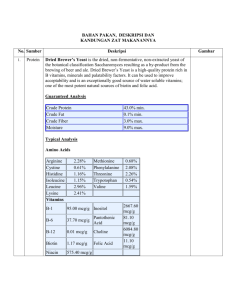Read the Feed Tag
advertisement

READ THE FEED TAG 1. Usually ingredients are listed starting with the item making up the largest percentage of the mixture and continuation with those added in smaller quantities. Collective feed names are used to avoid preparation of new tags if one or more ingredients were discontinued. Collective Feed Terms Grain Products Barley, corn, oats, wheat, rice and rye Animal Protein Products Fish meal, hydrolyzed poultry feathers, meat meal, dried whole milk, skimmed milk, dried whey` Plant Protein Products Cottonseed meal, linseed meal, soybean meal, soybeans (heat processed), yeast (cultured) Processed Grain By-Products Brewers dried grains, distillers dried grains, corn gluten feed, wheat millings, bran (rice and wheat) Forage Products Alfalfa meal (dehydrated or sun-cured), grass hay (Species name included), lespedeza meal Roughage Products Apple products (dried), barley hulls, beet pulp (dried), hulls (oat, peanut and rice) 2. Guaranteed analysis of equine complete feeds & supplements Minimum % crude protein (CP) Minimum amount of Se in ppm Minimum % crude fat Minimum amount of Zn in ppm Maximum % crude fiber (CF) Minimum amount of Vitamin A in IU/lb (if added) Minimum and maximum % of Ca Minimum % of P Minimum amount of copper in parts per million (ppm) 3. Guaranteed analysis for equine mineral feeds Minimum and maximum % of Ca Minimum % of P Minimum and maximum % of salt (if added) Minimum amount of copper in parts per million (ppm) Minimum amount of Se in ppm Minimum amount of Zn in ppm Minimum amount of Vitamin A in IU/lb (if added) 4. Commercial Feed Classes 1. Textured concentrates (sweet) – whole grains mixed with molasses to improve palatability. The grain may or may not be processed – crimped, cracked, rolled, or flaked). 2. Processed concentrates (pelleted or extruded) 3. Complete feeds – Combination of concentrates and forages into one product. 4. Supplements (protein, mineral, trace mineral and/or vitamin) Listed below are some common questions and answers when evaluating a feed tag. 1. Question: What should one look for on a tag to evaluate a feed? Answer: 1. Energy - best indicator, maximum %C.F. a. The best guide is the % C.F. in the ration. Percent C.F. is an estimate of the poorly digestible portion of the ration and includes the indigestible portion b. The higher the %C.F., the lower the digestible energy. 2. Protein – minimum %C.P. and sources such as soybean meal, flaxseed or other oil meals. 3. Check for vitamin sources (particularly vitamin A, D and E). 4. Check for minerals especially phosphorus and calcium. 2. Question: Are their suggested %C.F. figures as guides? Answer: a. Yes, in a complete hay, grain supplement ration the upper limits should not be over 25% C.F. and lower is better. Hay alone analyses as 30-33% C.F. and when mixed with ½ oats having 12% C.F., the average becomes 23% C.F. b. In a concentrated grain-protein formula to be offered with hay, the upper C.F. limit should not exceed 14% C.F. and a lower level is better. Oats has only 12% C. F. and corn only 3% C.F. When one purchases a concentrate to supplement hay, it is foolish to purchase more fiber. Generally the fiber from concentrates is very indigestible. 3. Question: I understand Crude Fiber has an energy value? Relationship of Crude Fiber to Expected Digestible Energy in Mixed Concentrate Feeds Crude Fiber, % Digestible Energy, Mcal/lb 2.0 1.62 4.0 1.55 6.0 1.45 8.0 1.35 10.0 1.25 12.0 1.15 4. Question: Is %C.P. important and what should be a minimum value? Answer: Yes a. Look at %C.P. for quantity and also look at protein sources for digestibility and quality. b. A level of 12%C.P. is minimum for adult working horses. Minimum levels of 14-16% are better for growth, reproduction and lactation. 5. Question: How can one determine % digestible protein (D.P.)? Answer: Protein from oil meals such as soybean meal, flaxseed, cottonseed meal and peanut meal usually are excellent digestible proteins. Crude protein is also furnished through natural hays and grains. Protein from hay is generally less digestible (60%) than from grains (80%). 6. Question: Is % crude fat important? Answer: Crude fat content is the % of ether extractable fat in the feed. The amount of fat is so low (3-4%) in most feeds that it is not a determining factor in which product to buy. However, there are some commercial feeds that contain between 5% and 10% supplemental fat, meaning that the tag will probably show a minimum crude fat % from 8-13. FEED TAG EXAMPLE Crude Protein (minimum) 12.0% Crude Fat (minimum) 2.5% Crude Fiber (maximum) 14.0% Calcium (minimum) 0.80% Calcium (maximum) 1.00% Phosphorus (minimum) 0.45% Ingredients: Grain products, plant protein products, processed grain-by products, forage products, riboflavin, calcium pantothenate, niacin, vitamin B12 supplement, choline chloride, vitamin A palmitate, D activated sterol (source of vitamin D3), vitamin E supplement, methionine, menadione sodium bisulfate (source of vitamin K activity), animal fat (preserved with BHA), deflourinated phosphate, magnesium sulfate, potassium sulfate salt, manganous oxide, iron carbonate, iron sulfate, copper oxide, cobalt carbonate, calcium iodate, zinc oxide, cane molasses, sodium selinite. Nutrient CP, % Crude Fat, % Crude Fiber, % Ca, % min. P, % min. Mg, % K, % Fe, ppm Cu, ppm Zn, ppm Mn, ppm Se, ppm Vit. A IU/lb Vit. D IU/lb Vit. E IU/lb EX 16 16 5.0 6.5 0.8 0.7 0.17 0.8 350 50 160 125 0.2 3000 540 70 EX 14 14 5.0 6.5 0.7 0.6 0.17 0.7 350 50 160 125 0.2 3000 540 70 EX 12 12 5.0 4.5 0.6 0.5 0.17 0.6 200 50 160 125 0.2 3000 540 70







